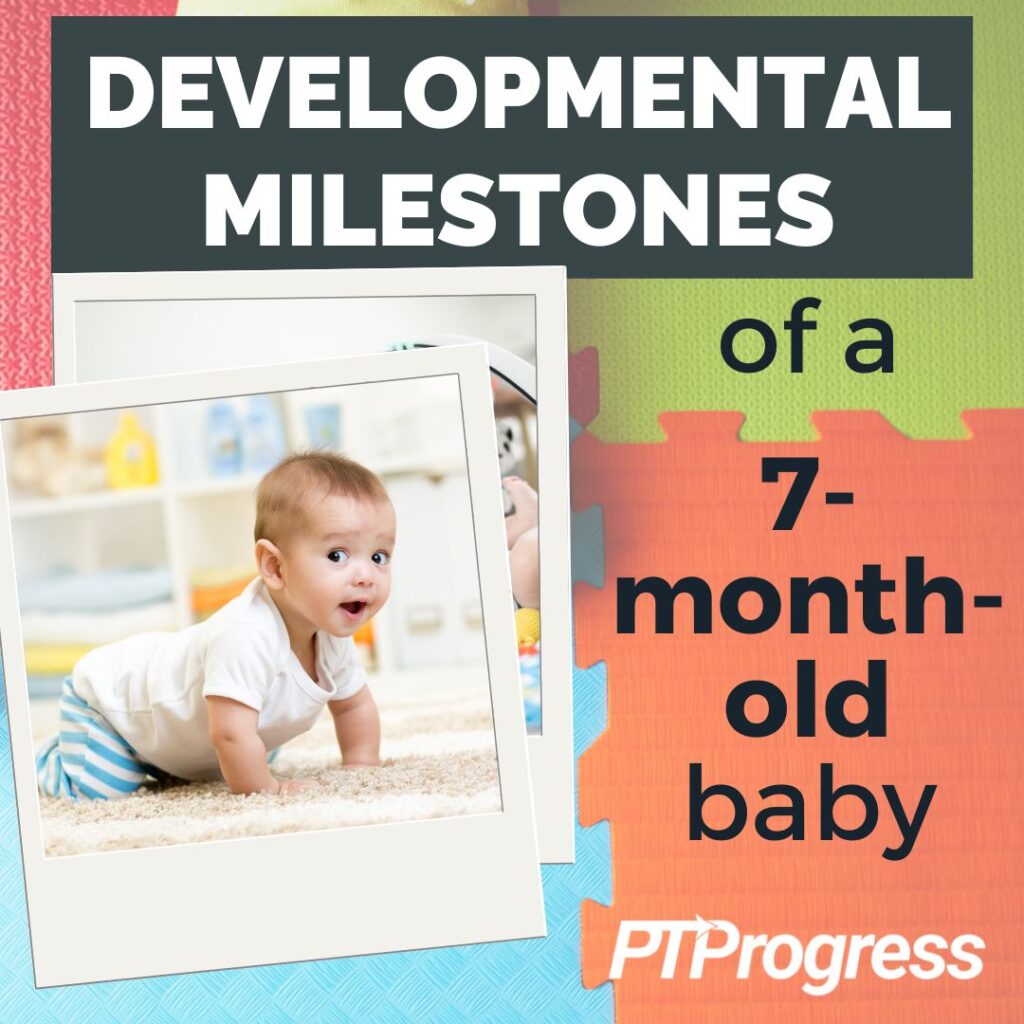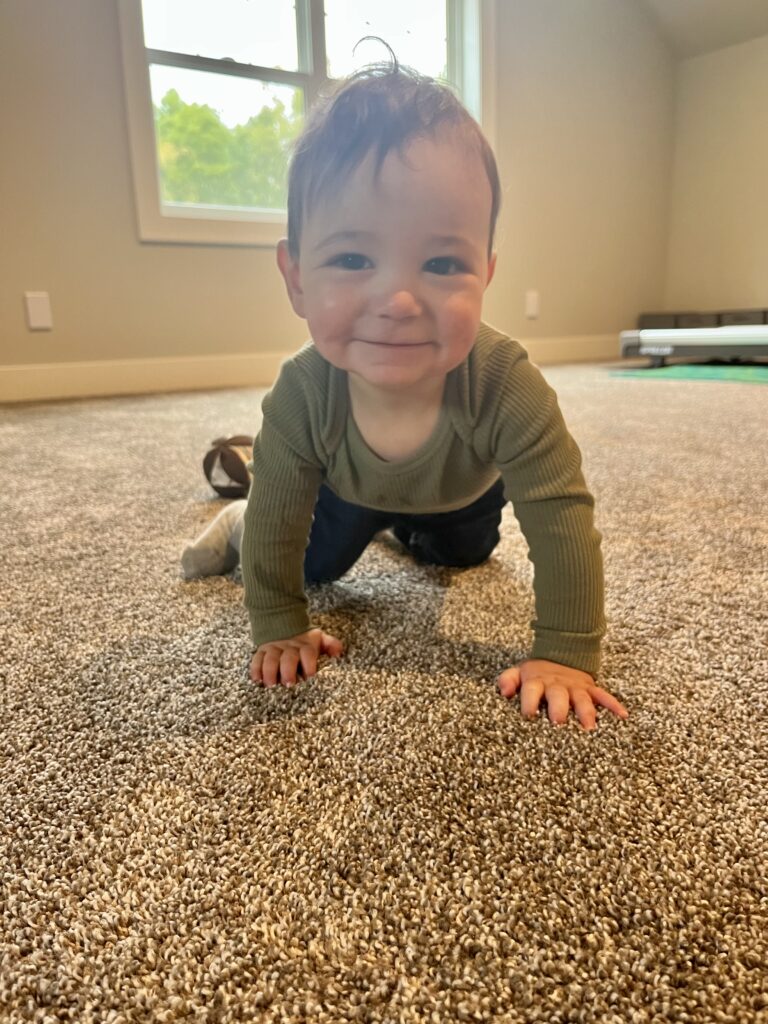
Watch out! Your 7-month-old is on the move—or about to be—and that means your life is getting a whole lot busier! Along with crawling (of sorts), your baby may be reaching some fun social milestones, such as clapping, facial recognition from across the room, and improved communication skills. You may also enjoy introducing new solid food to your baby (and embracing the mess it brings!). These are just some of the developmental milestones typical of a 7-month-old!
Regarding reflexes, no new ones will be appearing in your 7-month-old unless the STNR, discussed in last month’s guide, has yet to show. Be mindful of the other reflexes previously mentioned and watch for them to integrate or disappear into your baby’s library of movement. Remember, you can always talk to your pediatrician if you have any concerns about your baby’s development.
Keep reading for more in-depth information about developmental milestones for your 7-month-old baby!
Reflexes:
Usually by 7 months, there are no new reflexes to monitor. However, every child develops at different rates, so consider checking your baby’s progress against the reflexes discussed in the 5-month– and 6-month reports.
In the 5-month we covered details about the following:
- Palmar Grasp reflex
- Asymmetrical Tonic Neck Reflex (ATNR)
- Spinal Galant reflex
- Spinal Perez reflex
The following reflex was detailed in the 6-month report:
- Symmetrical Tonic Neck Reflex (STNR)
Keep in mind, these reports contain what is considered “normal” for reflex integration, but if your baby seems to be retaining reflexes for longer, there’s no need to panic. Just bring any questions or concerns to the attention of your child’s pediatrician, and they should be happy to refer you to an occupational therapist trained in reflex integration.

Developmental Milestones:
Mobility
At 7 months old, your baby is probably getting ready to crawl, if they haven’t already begun! Crawling typically starts between 7–10 months, but it may commence earlier or later depending on the baby.
Maybe your baby isn’t crawling exactly, but they still find ways to move. In lieu of crawling, your baby may be scooting in circles, rocking back and forth on all fours, or pulling themselves forward on their tummy with their arms.
My baby is crawling with one leg sticking out to the side. Is this normal?
Asymmetrical crawling
Yes, that is normal! It’s a form of asymmetrical crawling and nothing to worry about. Your baby is still learning how to coordinate their arms and legs, and that will take time. As they get used to this new movement, your baby should eventually crawl on all fours.
While asymmetrical crawling isn’t cause for immediate concern, it’s not an ideal form of locomotion for your baby. Crawling asymmetrically can lead to poor muscle development, an imbalanced pelvis and hip girdle, visual orientation impairment, or difficulties with overall body awareness.
So if you notice your baby asymmetrical crawling, try correcting their limbs by gently adjusting them as they move. If the atypical movements persist, consider reaching out to your pediatrician to see if there is an underlying cause.
Motor Control / Strength
A typical 7-month-old baby can sit independently without any support from their hands or other external objects. But they may still suffer the occasional loss of balance, so stay close and aware of your baby’s movements. Little Jack here in the photo was trying to pull off his sock and fell backwards (not to worry—he was okay!). For any baby, figuring out how to grade the force (strength) of movement is still a work in progress!
At this age, your baby may already be passing objects between their hands, and you should notice it happening more frequently and with better control. Using both sides of the body to complete a task is called bilateral coordination. This skill won’t fully develop until months from now, but you should see the beginnings of bilateral coordination around this time. Examples include whenever your baby pushes up with both hands, bangs two toys together, holds a toy with both hands, or passes a toy between their hands.
Your baby probably still prefers using a raking grasp to pick up food items or toys. But in time they will transition to a pincer grasp, between forefinger and thumb. That can start as early as 6 months but is more typical for babies 9 or 10 months old.
Cognition
All these physical changes you see in your baby are keeping pace with a host of cognitive changes as well. Your baby is probably trying to “talk” more and more, making sounds such as squeaking, screaming, and babbling. At times it may sound like they’re saying “mama” or other recognizable words, which can be super exciting! Besides making sounds, your baby may also be responding more to the sounds in their environment. For example, they may turn their heads toward you or smile in response to your voice.
Another way your baby will try to communicate is through crying. When they were younger, crying used to indicate one of a few things: hunger, a wet diaper, a tummy ache, or feeling tired. Now, they may cry for many other reasons as well, whether because they dropped their toy, they want a different toy, they want to be held, they want to be put down—and the list goes on! This tendency towards crying can make caring for your baby difficult and frustrating, but keep in mind that your baby is simply trying to communicate with you in the only way they know how. Try to stay patient and discern what they need.
Exploration and Independent Play
From communication to curiosity, the cognitive developments you see in your baby are impacting how they play. They are likely starting to explore more—whether it be their environment by moving and itching, or their toys by turning them in every direction for inspection. You may notice your baby more frequently getting into trouble by reaching for items that aren’t toys, such as cords, (little Jack’s personal favorite!). To that end, be sure to put away unnecessary objects and anything with which you don’t want your baby playing. And as always, keep a close eye on them during this exploratory phase!
Lastly, you may notice your baby engaging in independent play more often, and this skill can allow a bit more independence for you. Of course, I don’t mean you can now simply dump toys into their crib or pack-and-play and leave them there for hours on end. But you may be able to now let them play with their toys on the floor while you fold laundry or wipe down the counters, keeping a watchful eye nearby. Independent play is great for babies; it encourages them to figure things out on their own, such as placing shapes in a shape-sorter or pushing buttons to make sounds. At 7 months, you can expect your baby to stay entertained by themselves (under your observation) for around 5 minutes at a time.
Conclusion
Crawling, squirming, squeaking, and reaching—the life of a 7-month-old is busy and bright! As their parent, you can help ensure their proper development by looking for the skills and reflexes detailed in each monthly report and consulting your baby’s pediatrician anytime something seems amiss. But don’t obsess over milestones; enjoy your baby and the progress they have made already. They will very quickly grow and change even more!

